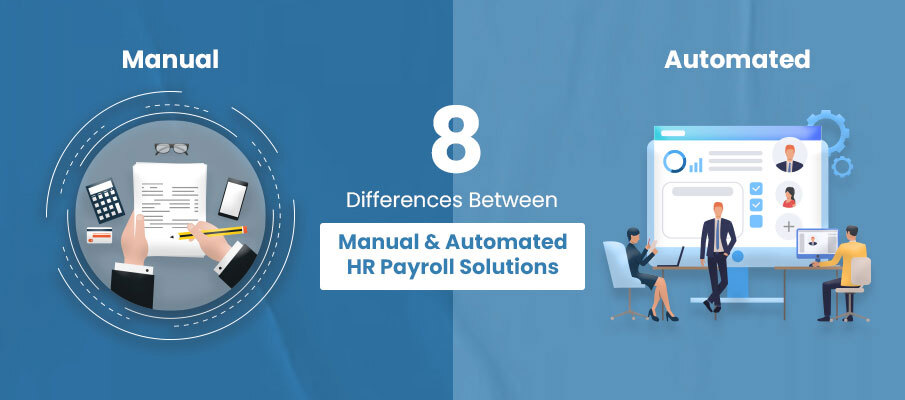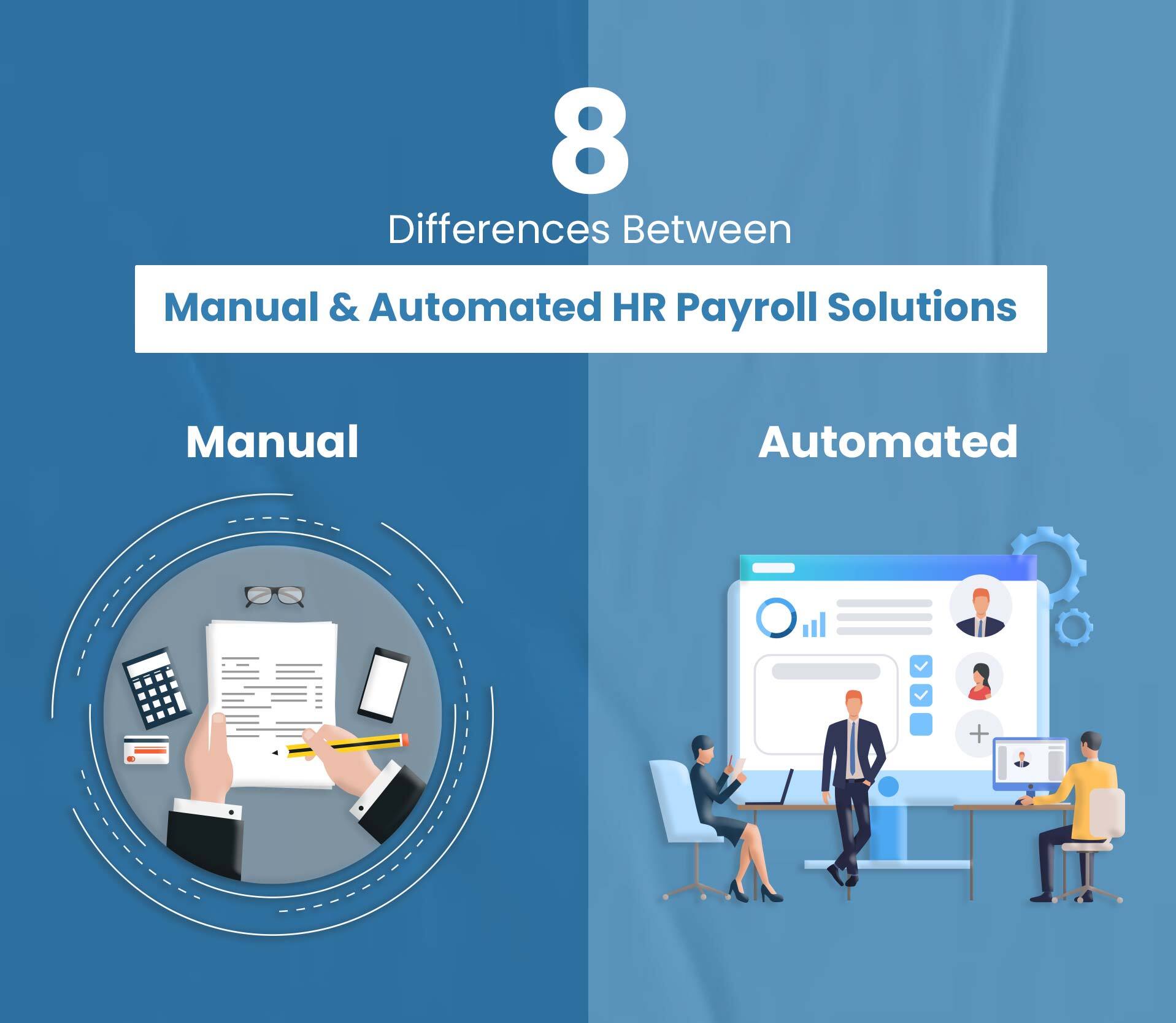Blog
Catch top stories, Stay updated with the trend
8 Differences Between Manual And Automated HR Payroll Solutions
In the fast-paced world of payroll management, businesses face a crucial decision: Manual or Automated HR Payroll Solution? The choice between these two methods can significantly impact an organization's efficiency, accuracy, and bottom line.
In this blog post, we'll delve into the key differences between manual and automated payroll solutions.
It will shed light on the advantages and disadvantages of each, helping you make an informed decision for your organization's payroll needs.
About Payroll Processing
Payroll processing refers to the “systematic and organized method of calculating, distributing, and recording employee compensation within an organization.”
This comprehensive process encompasses various tasks, including salary calculations, tax withholdings, benefit deductions, and generating paychecks or electronic transfers.
It ensures that employees are accurately and punctually compensated for their work.
What is a Manual Payroll System?
A manual payroll system is a “traditional, paper-based approach to managing an organization's payroll responsibilities.”
In this system, HR and finance teams rely on physical documentation, such as handwritten time sheets, paper checks, and ledger books, to calculate and process employee salaries, taxes, and deductions.
Manual payroll systems require meticulous attention to detail, as human errors can easily occur during calculations, potentially leading to discrepancies in employee pay.
Pros of Manual Payroll System
Here are a few pros of using a manual payroll system:
- Cost-Effective: Setting up and maintaining a manual system is often less expensive than implementing an automated one. Small businesses with limited resources may find it more cost-effective to handle payroll manually.
- Simplicity: Manual payroll systems are straightforward and easy to understand. They don't require complex software or specialized training, making them accessible to those with basic accounting knowledge.
- Control: With manual payroll, you have complete control over the process. You can quickly make adjustments or address specific employee requests without relying on software updates or external support.
- Personalized Attention: Handling payroll manually allows for a more personal touch. You can directly communicate with employees about their pay and resolve any issues promptly.
Cons of Manual Payroll System
Some of the cons of using a manual payroll system are given below:
Error-Prone: Manual calculations are susceptible to human errors, such as incorrect data entry, miscalculations, and oversight of important details. These errors can lead to discrepancies in employee pay and tax-related issues.
Time-Consuming: Processing payroll manually is a time-intensive task, especially as the number of employees and payroll complexities increase. It can take a significant amount of staff time to complete each pay cycle.
Compliance Challenges: Keeping up with changing tax laws and regulations can be challenging in a manual system. Filing taxes, managing deductions, and ensuring compliance with labor laws may become more difficult over time.
Security Risks: Physical payroll records and checks can be vulnerable to theft, loss, or damage. Protecting sensitive employee information and financial data can be more challenging with a manual system.
Lack of Reporting and Analysis: Manual systems often lack the robust reporting and analytical capabilities that automated systems offer. This limits the ability to gain insights from payroll data for strategic decision-making.
Employee Dissatisfaction: Errors or delays in payroll processing can lead to employee dissatisfaction and may damage morale. Employees depend on accurate and timely pay, and manual systems are more prone to payment issues.
Audit and Record-Keeping Challenges: Maintaining accurate records for auditing purposes can be cumbersome in a manual system. It may be more difficult to retrieve historical payroll data when needed.
What is an Automated Payroll System
An automated payroll system is a “digital and technology-driven solution designed to streamline and simplify the complex process of payroll management within organizations”.
Unlike manual payroll systems that rely on paper-based processes and manual calculations, automated systems leverage software and advanced algorithms to handle various aspects of payroll.
“ According to a report by Grand View Research, the global automated payroll software market was valued at USD 6.75 billion in 2020 and is expected to exhibit a compound annual growth rate (CAGR) of 8.2% from 2021 to 2028. This highlights the increasing adoption of automated payroll systems worldwide.”
It includes each and every task from calculating employee salaries and tax deductions to generating paychecks and maintaining detailed records.
Pros of Automated HR Payroll Solutions
The following are the pros of automated HR payroll solutions.
- Efficiency and Time Savings: Automated payroll systems significantly speed up the payroll process, reducing the time and effort required for calculations, data entry, and paperwork.
- Error Reduction: Automation minimizes the risk of human errors in payroll calculations, ensuring that employees are paid accurately and consistently.
- Compliance with Tax Regulations: These systems automatically calculate and withhold the correct amount of taxes, helping businesses stay compliant with ever-changing tax laws.
- Enhanced Data Security: Employee data is securely stored and protected in digital form, reducing the risk of data breaches or loss compared to paper-based systems.
- Streamlined Reporting: Automated systems generate comprehensive reports with ease, providing valuable insights into payroll expenses and trends.
- Scalability: As businesses grow, automated payroll systems can easily adapt to handle an increasing number of employees and more complex payroll needs.
- Employee Self-Service Options: Many automated systems offer self-service portals, empowering employees to access their pay stubs, tax forms, and other payroll-related information conveniently.
Cons of Automated Payroll System
Here you go with the major cons of automated HR payroll solutions:
- Initial Cost and Setup Complexity: Implementing an automated payroll system can come with a significant upfront cost, including software licensing, training, and potential hardware upgrades. The initial setup process can be complex too.
- Dependence on Technology: Automated payroll systems rely on technology, which means they can be vulnerable to technical issues, software glitches, and system downtimes.
- Ongoing Maintenance and Updates: Automated systems require regular maintenance and updates to ensure they remain compliant with changing tax laws and regulations.
- Limited Flexibility for Unique Scenarios: While automated systems excel at handling routine payroll tasks, they may struggle with unique or complex payroll scenarios that require manual intervention.
How Can An Automated System Help With Payroll Processing?
An automated system can significantly streamline payroll processing by automating calculations, tax withholdings, and payment disbursements.
It reduces the potential for human errors, ensuring accurate and consistent payments to employees.
These systems facilitate compliance with tax regulations and generate detailed reports, saving time and resources while enhancing overall payroll efficiency.
ErisHR One Helps To Set Up An Automated Payroll System!
ErisHR One presents an invaluable solution as payroll software in Dubai for those seeking to optimize their payroll processes through automation.
With our expertise and advanced technology, we are dedicated to assisting you in seamlessly transitioning to an automated payroll system.
By entrusting us with this pivotal aspect of your business, you can redirect your focus toward core operations while enjoying the benefits of enhanced accuracy and efficiency in payroll processing.
Wrapping Up
The distinctions between manual and automated HR payroll solutions are pivotal in shaping an organization's payroll management.
Your choice between these two approaches will impact not only the efficiency of your HR processes but also your overall business success.
Be sure to carefully consider your specific requirements, compliance needs, and long-term objectives before making the right decision for your company.
Does My Small Business Need a Website
Key Benefits of Having a Mobile App for Your Business
How to Outsource Your Business Digital Marketing
Why Small Businesses Need Custom Software Development
Importance of Search Engine Optimization for Small Businesses
What Is CRM And ERP And How It Can Be Beneficial For Businesses
6 Most Important Digital Assets for E Commerce Business
7 Most Common Web Design Mistakes Small Businesses Make
See All



.jpg)
